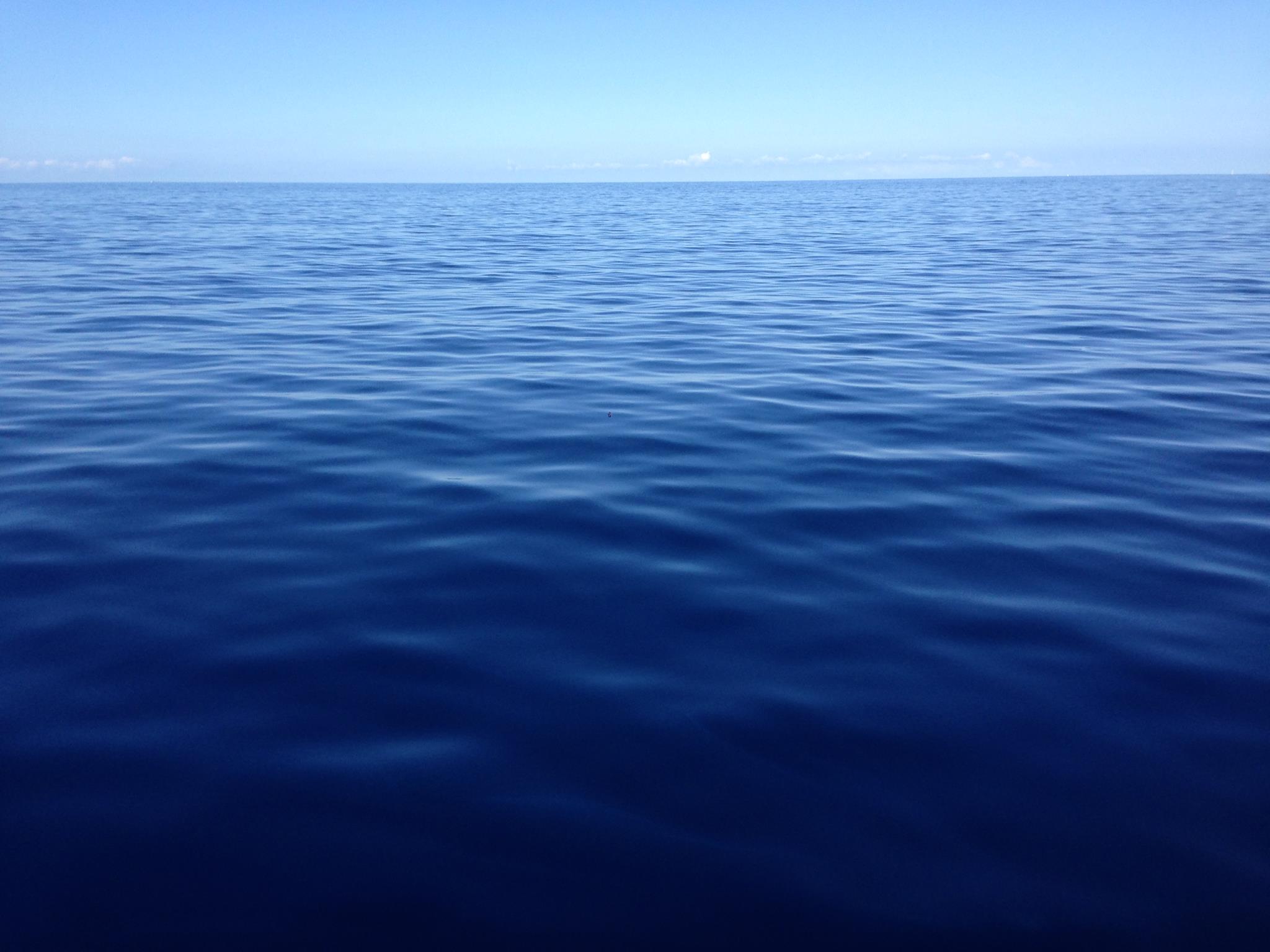 |
|
  |
Experimental studies on wave turbulence (papers by our group)
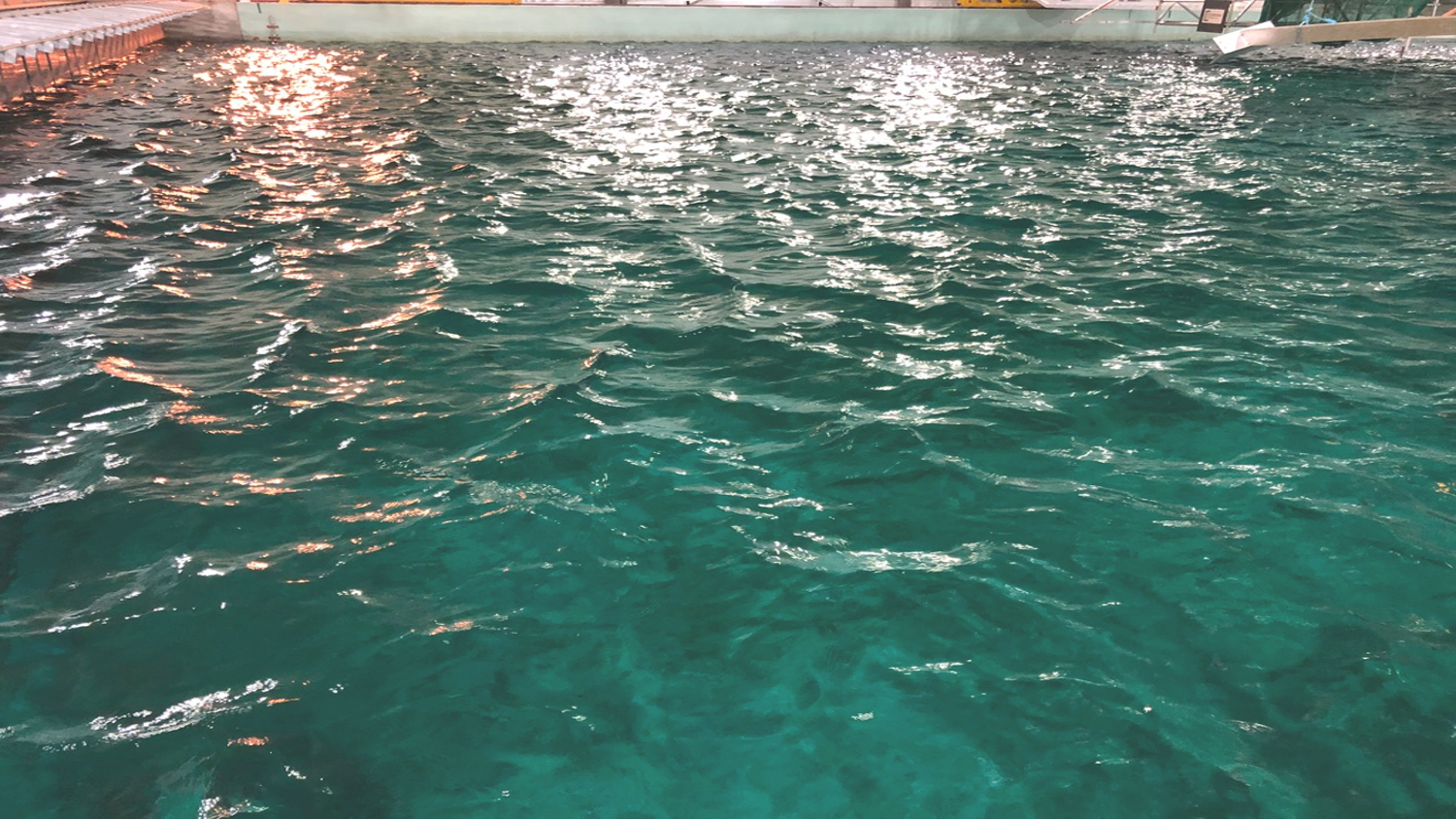 Wave turbulence
is a domain rapidly expanding for several years. It concerns
the study of the dynamical and statistical properties of a
set of numerous waves in interaction. This is a ubiquitous
phenomenon that occurs in various situations on very different scales: from spin waves in solids,
internal or surface waves in oceanography up to plasma waves
in astrophysics.
Wave turbulence
is a domain rapidly expanding for several years. It concerns
the study of the dynamical and statistical properties of a
set of numerous waves in interaction. This is a ubiquitous
phenomenon that occurs in various situations on very different scales: from spin waves in solids,
internal or surface waves in oceanography up to plasma waves
in astrophysics.Our projects on wave turbulence are funded by French funding: ANR Turbonde 2007-2011, ANR Turbulon 2012-2016, and ANR Dysturb 2017-2022, and by USA funding: Simons Foundation (New York, USA) MPS 2019-2023, and Simons Foundation (New York, USA) MPS 2023-2026 on Wave Turbulence
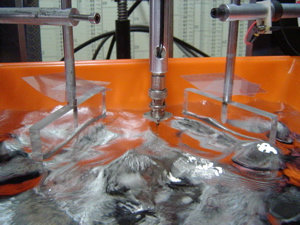 |
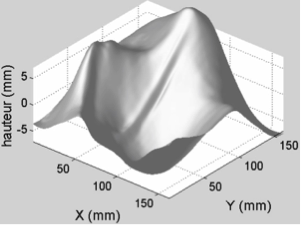 |
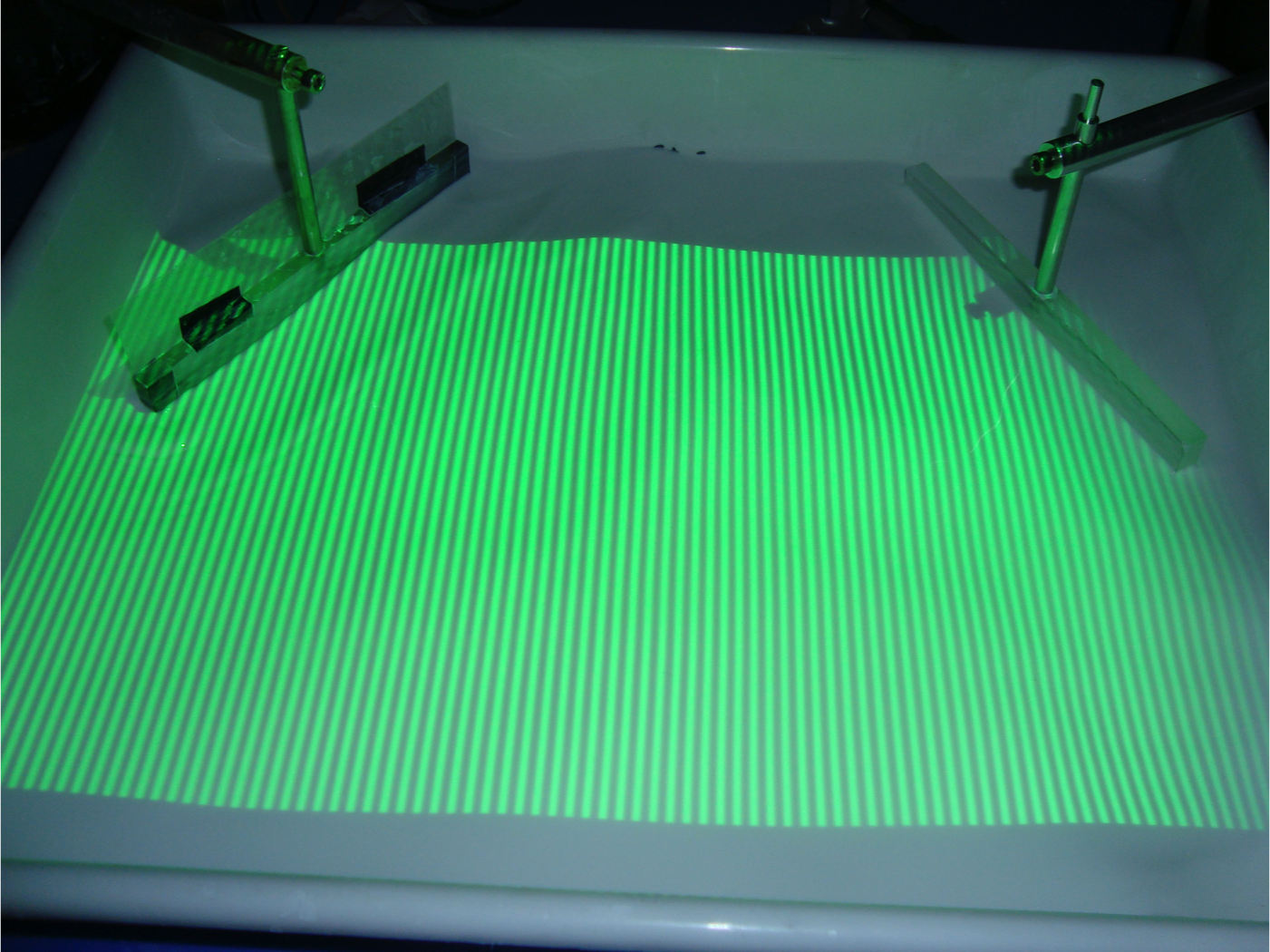 |
We have observed in laboratory the regime of gravity-capillary wave turbulence [1], and have reported the first experimental observation of intermittency in wave turbulence [2]. The intermittency is shown to not come from some coherent structures at large scale (wavebreakings, capillary bursts on steep gravity waves) [10,11]. Moreover, two major experimental challenges have been faced: the measurement of injected power [3], and of the wave field fully resolved in space and time [12]. At the time, those quantities were not yet been measured directly for wave turbulence on the surface of a fluid. Two main results have then been obtained: (i) Energy transfer mechanisms are not restricted to purely resonant wave interactions, as assumed by the theory, but involved other mechanisms related to the presence of strong nonlinear waves (sharp crested waves, bound waves, ...) [12]; (ii) The system shows large injected power fluctuations within the fluid [3], fluctuations not taken into account by weak turbulence theory. We showed that the distribution of injected power fluctuations is well described by a simple model [7]. A book chapter has been also published on the fluctuations in wave turbulence [19], as well as reviews on wave turbulence [6, 9].
We have then reported the first observation in laboratory of the direct gravity-capillary cascade when the fluid is not in a deep-water regime [14]. The study of nonstationary regime of capillary-wave turbulence, when the forcing is stopped, led to the first observation of decay wave turbulence [16]. Another optical method (different form Fourier Transform Profilometry used in [12]) called Diffusing Light Videography, has been used to reconstruct the capillary wave field both in time and space. We have highlighted the role of strongly nonlinear capillary waves on the turbulent dynamics [18, 30]. The study of 3-wave interactions between gravity-capillary waves allows us to validate experimentally, for the first time for noncolinear waves, the theory of 3-wave resonant interactions [24]. We have also obtain the first indirect measurement of the energy flux at each scale of the turbulent cascade [21]. As a consequence, the highlighting of dissipation at all scales of the capillary turbulent cascade (not taken into account in the current stage of theoretical developments) allowed to understand the disagreements observed, these last years, in numerous experiences on capillary wave turbulence. The constant of the Kolmogorov-Zakharov spectrum was also inferred experimentally for the first time and compared with its theoretical value [21, 23]. Besides, we performed the first direct numerical simulations of capillary wave turbulence from the two-phase Navier-Stokes equations [22]. These simulations confirm the validity of weak turbulence derivation when hypotheses are verified. Finally, we have studied for the first time wave turbulence on the interface between two immiscible fluids with free upper surface. We show that the coupling between free surface waves and interface waves modify strongly the wave turbulence regime [26]. We have also highlighted strong capillary-wave turbulence for which the interaction mechanism between waves becomes nonlocal and nonresonant (energy transfer through intermittent bursts) [30]. When viscous dissipation is significant, we demonstrated that the bandwidth of the free-surface transfer function is increased, allowing for three-wave interactions that do not satisfy the dispersion relation [33]. Finally, we reported the observation of nonlinear three-wave resonant interactions between two different branches of the dispersion relation of hydrodynamic waves, namely the gravity-capillary and sloshing modes [42]. Such a three-wave two-branch interaction mechanism is probably not restricted to hydrodynamics and could be of interest in other physical systems involving several propagation modes.
 Gravity wave turbulence is of paramount interest in oceanography but remains poorly understood [32]. Beyond observing the direct cascade of gravity wave turbulence, we showed in the laboratory that the gravity-wave spectrum is nonuniversal and depends on the forcing parameters [1]. We also reported the first laboratory observation of an inverse cascade of gravity-wave turbulence, but that was limited to a narrow inertial range due to the small-sized container used [15]. Moreover, we experimentally showed that a spatially homogeneous forcing leads to a good agreement with theoretical predictions [17], contrary to previous observations with a localized forcing with wavemakers.
Gravity wave turbulence is of paramount interest in oceanography but remains poorly understood [32]. Beyond observing the direct cascade of gravity wave turbulence, we showed in the laboratory that the gravity-wave spectrum is nonuniversal and depends on the forcing parameters [1]. We also reported the first laboratory observation of an inverse cascade of gravity-wave turbulence, but that was limited to a narrow inertial range due to the small-sized container used [15]. Moreover, we experimentally showed that a spatially homogeneous forcing leads to a good agreement with theoretical predictions [17], contrary to previous observations with a localized forcing with wavemakers. We then conducted several measurement campaigns within a large-scale wave basin (50 m x 30 m x 5 m) at Ecole Centrale Nantes, France, to study gravity wave turbulence. The turbulent wave field is experimentally found to strongly depend on the basin boundary conditions (absorbing - beach or reflecting - wall) although their statistical and spectral properties are close [23]. We have also studied resonant interactions between nonlinear waves which are the fundamental mechanism that transfers energy in wave turbulence. The study of four-wave interactions between gravity waves allows us to validate experimentally, for the first time for noncolinear or perpendicular waves, the theory of four-wave resonant interactions [25]. For stronger nonlinearities, meaningful departures from this weakly nonlinear theory are observed [28]. Then, we reported the first experimental formation of the inverse cascade in gravity wave turbulence [36] stopped (not by finite-size effects as in [15]) by the emergence of nonlinear dissipative structures such as sharp-crested waves. We also showed that the presence of nonlinear coherent structures explains discrepancies from predictions of gravity-wave turbulence observed in oceanography and laboratory experiments [29].
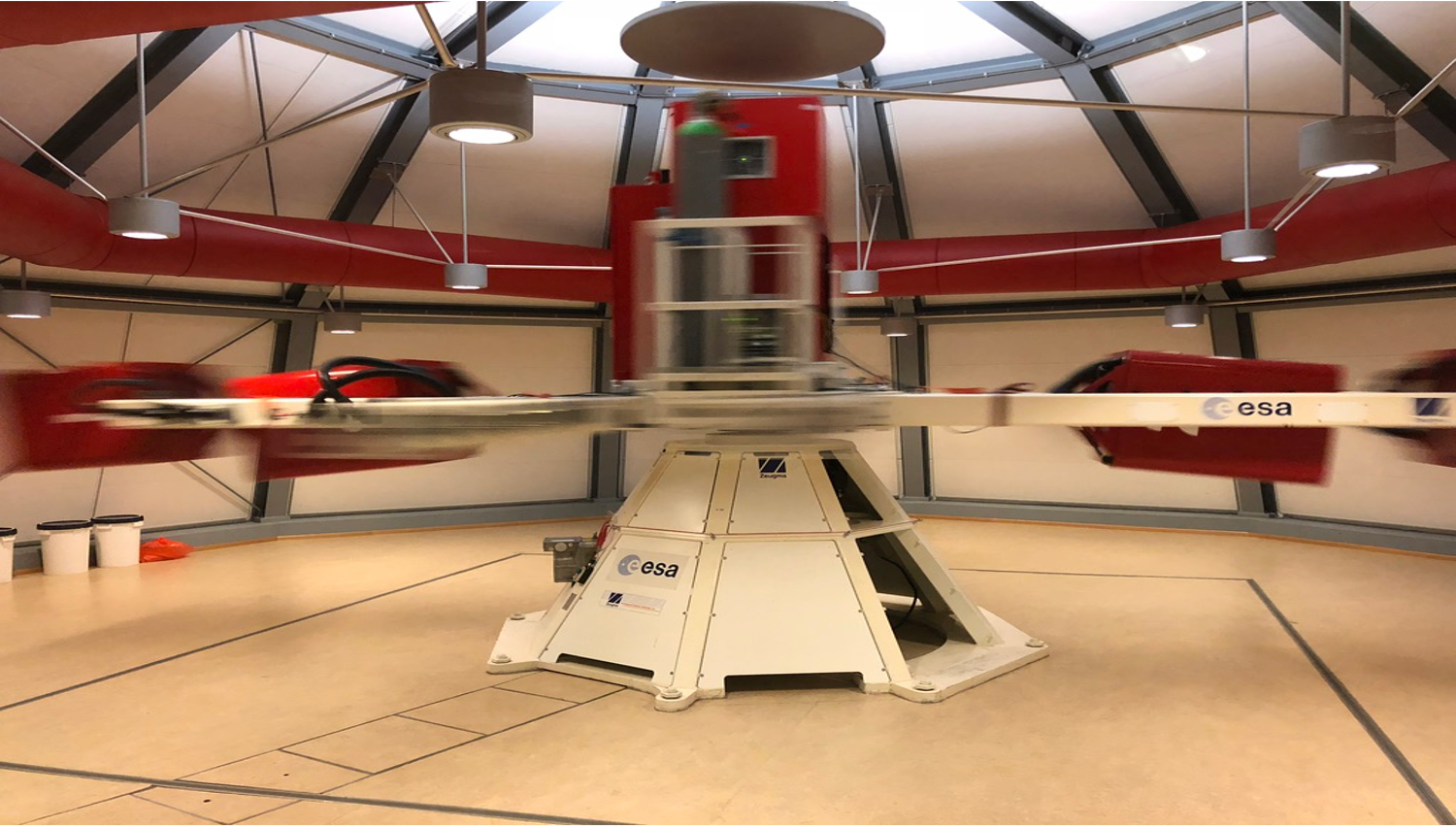 By using the Large Diameter Centrifuge (LDC) of the European Space Agency, we were able to increase gravity by a factor of 1 to 20 times Earth's gravity to significantly extend the range of observable scales of gravity-wave turbulence in the laboratory. Moreover, the usual energy transfers (interaction between nonlinear waves) are found to be modified by the finite-size effects of the system [34].
By using the Large Diameter Centrifuge (LDC) of the European Space Agency, we were able to increase gravity by a factor of 1 to 20 times Earth's gravity to significantly extend the range of observable scales of gravity-wave turbulence in the laboratory. Moreover, the usual energy transfers (interaction between nonlinear waves) are found to be modified by the finite-size effects of the system [34]. Wave turbulence in low-gravity environments

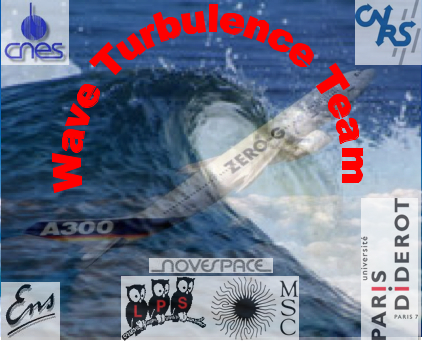 We studied pure capillary
waves in low-gravity environment during CNES Parabolic Flight
Campaigns. We have observed pure capillary wave turbulence on a
broad range of scales usually masked by the gravity wave
regime on Earth [8]. Another advantage is to
have a system with no boundary, the fluid covering all the internal surface of a spherical or cylindrical cell in low-gravity.
Various patterns (hexagons, lines) have also been observed on
a spherical fluid surface when the forcing is periodic [8]. See pictures of wave turbulence in space ; See also pictures of the team in Space
We studied pure capillary
waves in low-gravity environment during CNES Parabolic Flight
Campaigns. We have observed pure capillary wave turbulence on a
broad range of scales usually masked by the gravity wave
regime on Earth [8]. Another advantage is to
have a system with no boundary, the fluid covering all the internal surface of a spherical or cylindrical cell in low-gravity.
Various patterns (hexagons, lines) have also been observed on
a spherical fluid surface when the forcing is periodic [8]. See pictures of wave turbulence in space ; See also pictures of the team in SpaceThis experiment of pure capillary wave turbulence was also performed for stronger forcing conditions onboard the International Space Station (ISS) in 2018 and 2021, in particular during CNES and ESA missions of the French astronaut Thomas Pesquet. The experiment called FLUIDICS (FLUId DynamICs in Space) was co-funded by CNES and Airbus. Strong wave turbulence is evidenced [31, 35].
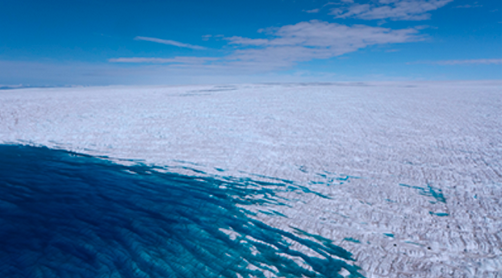 Hydroelastic waves, such as gravity-bending waves, are found in various areas: on the surface of lakes or oceans covered with ice, in very large floating structures in oceanography, or in biomedical applications such as heart valves.
Hydroelastic waves, such as gravity-bending waves, are found in various areas: on the surface of lakes or oceans covered with ice, in very large floating structures in oceanography, or in biomedical applications such as heart valves.
Hydroelastic wave turbulence focuses on random waves propagating on the surface of a fluid covered by an elastic sheet. It has been obtained for the first time in laboratory [20]. The
existence of three-wave interactions, predicted
theoretically in this system, has been
highlighted experimentally [27]. Moreover, in this system, we also reported the first observation of the statistical equilibrium regime – corresponding to energy equipartition between modes – of large scales turbulent waves [44]. We showed that even in such a turbulent system, certain laws of thermodynamics apply. These results offer a new way of understanding large-scale turbulence, using the tools of statistical physics.
When the forcing is stopped, we also reported the experimental study of the free decay of large-scale hydroelastic turbulent waves from this statistical equilibrium state [45]. This opens a new direction for understanding how turbulent wave fields ``cool down” after statistical equilibrium is reached, with implications from oceanic wave–ice interactions to floating structures.
Quasi-1D wave turbulence
Weak turbulence theory has been assessed experimentally in various wave systems propagating in two or three dimensions, but not in quasi-1D geometry since low-order resonant wave interactions are theoretically prohibited. We experimentally evidence, for the first time, quasi-1D capillary wave turbulence on the surface of a fluid in a canal. We also show that five-wave resonant interactions are the process generating such 1D capillary wave turbulence, which thus differs deeply from the 2D propagating case. We also report the first direct numerical simulation of quasi-1D capillary-wave turbulence [37].
Quasi-nondispersive wave turbulence
We experimentally focused on the role of dispersion in wave turbulence, a subject that has received little attention although weak turbulence theory assumes wave dispersivity. Using a magnetic fluid in a canal, we experimentally reported a transition from dispersive wave turbulence to a non-dispersive regime dominated by random shock waves [41]. This is the first observation of a set of random shock waves on the surface of a fluid. We then demonstrated experimentally that this regime generates strong small-scale intermittency in agreement with a Burgerslike intermittency model, modified to account for the finite steepness of the experimental shock-wave fronts [43]. This intermittency is much more intense than the one previously reported in three-dimensional hydrodynamic turbulence or in wave turbulence.
Magnetic wave turbulence and MHD
We reported the first observation of a magnetic wave turbulence regime on the surface of a magnetic fluid submitted to a normal magnetic field [5]. To wit, we used a ferrofluid (a suspension of nanometric magnetic particles within a carrier liquid) for which its wave dispersion relation can be tuned by a magnetic field. The existence domains of gravity and capillary wave turbulence are also documented as well as a triple point of coexistence of these three regimes that are understood using dimensional analysis. Such an experimental system where the dispersion relation is tuned by the operator from a dispersive to a nondispersive system is thus of primary interest to test the wave turbulence theory (see above). The case of a magnetic field parallel to the fluid surface shows several differences with the normal case. The striking one is the meaningful broading of the inertial domain of the magnetic wave turbulence regime [13]. We have also carried out numerical work (three-dimensional direct numerical simulation) of free-surface magnetohydrodynamic wave turbulence, which demonstrates the existence of an analogy between anisotropic Alfvén wave turbulence in plasmas and wave turbulence on the surface of a magnetic fluid [40].
47. T. Singla, J.-B. Gorce, and E. Falcon 2026
submitted to Phys Rev. Fluids (2026)
Finite-system size effects in gravity-capillary wave turbulence
46. J. Barckicke, E. Falcon, and C. Gissinger 2026
in press in Nature Physics (2026)
Kelvin wave propagation along vortex cores
45. M. Vernet and E. Falcon 2026
submitted to J. Fluid Mech. (2026)
Collapse of statistical equilibrium in large-scale hydroelastic turbulent waves,
44. M. Vernet and E. Falcon 2025
Physical Review Letters 135, 024004 (2025) ![]()
Thermodynamics and statistical equilibrium of large-scale hydroelastic wave turbulence
43. G. Ricard and E. Falcon 2023
Physical Review E 108, 045106 (2023)
Experimental evidence of random shock-wave intermittency
42. F. Novkoski, C.-T. Pham, and E. Falcon 2023
Physical Review E 107, 045101 (2023)
Evidence of experimental three-wave resonant interactions between two dispersion branches
41. G. Ricard and E. Falcon 2023
Physical Review Fluids 8, 014804 (2023)
Transition from wave turbulence to acousticlike shock wave regime
40. E. Kochurin, G. Ricard, N. Zubarev, and E. Falcon 2022 ![]()
Physical Review E 105, L063101 (2022)
Three-dimensional direct numerical simulation of free-surface magnetohydrodynamic wave turbulence
39. E.
Falcon and
N. Mordant 2022
Annual
Review of
Fluid
Mechanics 54,
1-25 (2022)
Experiments in gravity-capillary wave
turbulence
38. G.
Ricard and E.
Falcon 2021
Europhysics
Letters (EPL)
135, 64001
(2021)
Experimental quasi-1D capillary-wave
turbulence on
the surface of
a fluid
37. E. Kochurin, G. Ricard, N. Zubarev & E. Falcon 2020
JETP Letters 112, 757 - 763 (2020)
Numerical Simulation of Collinear Capillary-Wave Turbulence
36. E. Falcon, G. Michel, G. Prabhudesai, A. Cazaubiel, M. Berhanu, N. Mordant, S. Aumaître & F. Bonnefoy 2020
Physical Review Letters 125, 134501 (2020)
Saturation of the Inverse Cascade in Surface Gravity-Wave Turbulence
EPL (Europhysics Letters) 128, 34001 (2019)
Capillary
wave
turbulence
experiments in
microgravity
![]()
![]()
Physical Review Letters 123, 244501 (2019)
Wave
turbulence on
the surface of
a fluid in a
high-gravity
environment
![]()
Physical Review Fluids 4, 074803 (2019)
Forced
three-wave
interactions
of
gravity-capillary
surface waves
32.
E.
Falcon 2019
Applications in Nonlinear Dynamics (V. In, P. Longhini,
A. Palacios,
Eds.),
Springer
Nature, Chap.
25, pp. 259 –
266 (2019)
Wave
Turbulence: A
Set of
Stochastic
Nonlinear
Waves in
Interaction
Report to COSPAR (World Committee for Space Research), 42th Scientific Assembly, 14-22 July 2018, Pasasena, USA, CNES Ed., p. 66 - 67 (2018)
Wave turbulence in microgravity
30.
M.
Berhanu, E.
Falcon
& L. Deike
2018
Journal
of
Fluid Mechanics
850,
803 (2018)
Turbulence
of capillary
waves forced
by steep
gravity waves
29.
G.
Michel, B.
Semin, A.
Cazaubiel, F.
Haudin, T.
Humbert, S.
Lepot, F.
Bonnefoy, M.
Berhanu &
E. Falcon
2018
Physical Review Fluids 3, 054801 (2018)
Self-similar
gravity wave
spectra
resulting from
the modulation
of bound waves
28.
F. Bonnefoy,
F. Haudin, G.
Michel, B.
Semin, T.
Humbert, S.
Aumaître, M.
Berhanu &
E. Falcon
2017
La
Houille
Blanche 5,
56 (2017)
Experimental
observation of
four-wave
resonant
interactions
in a wave
basin
27. L.
Deike, M. Berhanu & E. Falcon 2017
Physical Review
Fluids 2, 064803
(2017)
Experimental observation of
hydroelastic three-wave interactions
26. B.
Issenmann, C. Laroche & E. Falcon 2016
EPL 116, 64005 (2016)
Wave
turbulence in a two-layer fluid:
coupling between free surface and
interface waves
25. F. Bonnefoy, F. Haudin, G.
Michel, B. Semin, T. Humbert, S. Aumaître, M. Berhanu & E.
Falcon 2016
Journal
of Fluid Mechanics (Rapids) 805,
R3 (2016)
Observation of resonant
interactions among surface gravity waves
24. F.
Haudin, A. Cazaubiel, L. Deike, T. Jamin, E.
Falcon and M. Berhanu 2016
Physical Review E 93,
043110 (2016)
Experimental study
of three-wave interactions among
capillary-gravity surface waves
23. L. Deike, B. Miquel, P. Gutiérrez, T.
Jamin, B. Semin, M. Berhanu, E. Falcon & F.
Bonnefoy 2015
Journal
of Fluid Mechanics 781, 196 (2015)
Role of the basin boudary conditions
in gravity wave turbulence
22. L. Deike, D. Fuster, M. Berhanu, E.
Falcon 2014
Physical
Review Letters 112, 234501 (2014)
Direct
numerical simulations of capillary wave turbulence
21.
L. Deike, M.Berhanu & E. Falcon 2014
Energy flux
measurement from the dissipated energy in capillary wave
turbulence
Physical Review E 89, 023003
(2014)
20. L. Deike, J.-C. Bacri & E.
Falcon 2013
Nonlinear waves on
the surface of a fluid covered by an elastic sheet
Journal of
Fluid Mechanics 733, 394 (2013)
19. S.
Aumaître, E.
Falcon
& S. Fauve
2013
Fluctuations
of the Energy Flux in Wave Turbulence
Advances In Wave
Turbulence (Ed. V.
Shrira, S.
Nazarenko, World
Scientific, Chap.
2, pp. 53-72,
2013)
18. M.Berhanu & E.
Falcon 2013
Space-time-resolved
capillary wave turbulence
Physical Review E 89,
033003 (2013)
17. B.
Issenmann & E. Falcon 2013
Gravity wave
turbulence revealed by horizontal vibrations of the
container
Physical Review E 87,
011001(R) (2013)
16. L. Deike, M. Berhanu
& E. Falcon 2012
Decay of capillary wave
turbulence
Physical Review E 85,
066311 (2012)
15. L. Deike,
C.Laroche & E. Falcon 2011
Experimental
study of the inverse cascade in gravity wave turbulence
EPL 96,
34004 (2011)
14. E. Falcon & C.Laroche 2011
Observation
of depth-induced properties in wave turbulence on the
surface of a fluid
EPL 94,
34003 (2011)
13.
S. Dorbolo & E. Falcon
2011
Wave
turbulence on the surface of a ferrofluid in a horizontal
magnetic field
Physical Review E 83,
046303 (2011)
12. E. Herbert, N. Mordant
& E. Falcon 2010
Observation of
the nonlinear dispersion relation and spatial statistics
of wave turbulence on the surface of a fluid
Physical Review Letters
105, 144502 (2010)
11. E. Falcon, S. G. Roux & B.
Audit 2010
Revealing
intermittency in experimental data with steep power
spectra
EPL 90,
50007 (2010)
10. E. Falcon, S. G. Roux & C. Laroche 2010
On the origin of intermittency in wave turbulence
EPL 90, 34005 (2010)
9. E.
Falcon 2010
Laboratory experiments on
wave turbulence
Discrete and
Continuous Dynamical Systems - Series B Vol. 13, N°4, 819 - 840 (2010)
8. C. Falcón, E. Falcon, U. Bortolozzo & S.
Fauve 2009
Capillary wave turbulence
on a spherical fluid surface in zero gravity
EPL 86,
14002 (2009)
7. C. Falcón
& E. Falcon 2009
Fluctuations of
energy flux in a simple dissipative out-of-equilibrium
system
Physical Review E 79,
041110 (2009)
6. E. Falcon 2008
Etudes Expérimentales en Turbulence
d'Ondes
Habilitation à Diriger les
Recherches, 244 pages, Université Paris Diderot (2008) (in french)
5. F. Boyer &
E. Falcon
2008 ![]()
![]()
Wave
turbulence on the surface of a ferrofluid in a magnetic
field
Physical Review Letters 101, 244502 (2008)
4. S. Fauve & E. Falcon 2008
Gravity-capillary
wave turbulence
Report to COSPAR (World Committee for Space Research), 37th Scientific Assembly, 13-20 July 2008, Montréal, Canada, CNES Ed., p. 90 - 91 (2008)
3. E. Falcon, S. Aumaître, C. Falcón, C. Laroche & S.
Fauve 2008
Fluctuations of energy flux
in wave turbulence
Physical Review Letters 100, 064503 (2008)
2.
E. Falcon, S. Fauve & C. Laroche 2007
Observation of
intermittency in wave turbulence,
Physical
Review Letters 98,
154501 (2007)
1. E. Falcon, C. Laroche &
S. Fauve 2007
Observation of
gravity-capillary wave turbulence,
Physical Review Letters 98,
094503 (2007)
